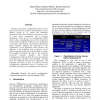Free Online Productivity Tools
i2Speak
i2Symbol
i2OCR
iTex2Img
iWeb2Print
iWeb2Shot
i2Type
iPdf2Split
iPdf2Merge
i2Bopomofo
i2Arabic
i2Style
i2Image
i2PDF
iLatex2Rtf
Sci2ools
DAGSTUHL
2006
2006
Physical 2D Morphware and Power Reduction Methods for Everyone
Dynamic and partial reconfiguration discovers more and more the focus in academic and industrial research. Modern systems in e.g. avionic and automotive applications exploit the parallelism of hardware in order to reduce power consumption and to increase performance. State of the art reconfigurable FPGA devices allows reconfiguring parts of their architecture while the other configured architecture stays undisturbed in operation. This dynamic and partial reconfiguration allows therefore adapting the architecture to the requirements of the application while run-time. The difference to the traditional term of software and its related sequential architecture is the possibility to change the paradigm of brining the data to the respective processing elements. Dynamic and partial reconfiguration enables to bring the processing elements to the data and is therefore a new paradigm. The shift from the traditional microprocessor approaches with sequential processing of data to parallel processi...
Architectures | DAGSTUHL 2006 | DAGSTUHL 2007 | Partial Reconfiguration | Partial Reconfiguration Enables |
| Added | 30 Oct 2010 |
| Updated | 30 Oct 2010 |
| Type | Conference |
| Year | 2006 |
| Where | DAGSTUHL |
| Authors | Jürgen Becker, Michael Hübner, Katarina Paulsson |
Comments (0)

